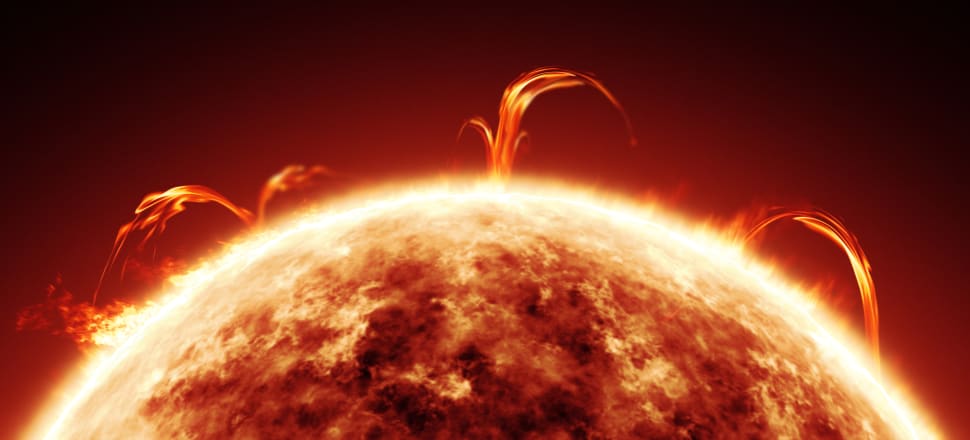
Dr Jonathan Squire explains the physics involved in the National Ignition Facility’s fusion breakthrough that made world headlines this week, and why it’s such a big deal for the future of clean energy.
Every second, the Sun generates enough energy to satisfy humanity’s electricity needs for four million years. It will continue, unabated, for another eight billion years. This unimaginable energy output all comes from smashing together hydrogen atoms to make helium – a process known as fusion.
If we could harness this in our power plants we’d have an ideal energy source. One kilogram of fuel, mostly hydrogen found in seawater, would power as much as 800 truckloads (30 million kg) of coal. With only tiny amounts of helium as waste (useful for party balloons) and no carbon emissions. With no outages (like wind or solar) and no possibility of dangerous meltdowns. The catch?
It’s really, ridiculously, difficult.
READ MORE: * Fusion energy waiting in the wings * Is NZ looking at a fusion future?
But earlier this week, scientists at the National Ignition Facility (NIF) in California announced a great step forward. They achieved fusion ‘breakeven’ for the first time, meaning their experiment released more energy from fusion than they had to put in to get it started.
Think of it like putting a log on the fire; you need heat to get it started, but once it gets going, you’ll be nice and toasty. Similarly, energy from NIF’s lasers started fusion going, the heat of this started more fusion, running away to make more energy than they put in. Although, unfortunately, this does not translate directly into commercial fusion electricity (there remain some big hurdles), it’s a massive science advance that’s been 70 years in the making.
The physics
Fusion is the process where the nucleus of a light element (hydrogen) ‘fuses’ to make a heavier element (helium). It’s the opposite of nuclear power from ‘fission’, where a heavy element (usually uranium) breaks into smaller ones. The hydrogen going in weighs just slightly more – around 0.4 percent – than the helium coming out, and this deficit becomes pure energy through E=mc2. If 0.4 percent sounds unexciting, consider this: just 1.5kg of hydrogen would be sufficient to power New Zealand for a full day.
The hard part is getting it going. Hydrogen nuclei are tiny balls of charge that repel each other extremely strongly. The corollary is that they must move unimaginably fast to come into contact and start fusion reactions. This means heat, and lots of it. Temperatures above at least 10 million degrees. In the centre of stars like our Sun, this heat comes from the incredible weight of everything squeezing from above – not a practical solution for Earth. Worse, our best materials melt at around 4000 degrees – not even close. So how do you build a box to contain stuff that’s so hot it would instantly melt any wall we can imagine making?
Scientists have two main approaches. The first, known as Inertial Confinement Fusion, was used by NIF in their recent breakthrough. The idea is to give up on the box entirely and just smack it. Really really hard. Sure, you don’t keep the hydrogen for very long – around a hundred-millionth of a second – but this doesn’t matter if you’ve fused lots of hydrogen (and released lots of energy) before it escapes. NIF achieves this by using 192 enormously powerful lasers, all focused on a fuel pellet smaller than your fingernail. This colossal dump of power compresses the hydrogen, which is usually so light it will float away in a balloon, to densities 100 times that of solid lead.
The second main approach is known as Magnetic Confinement Fusion. Here, the idea is to build a bottle, not from physical walls, but from magnetic fields. Then you just heat it up, watch the fusion go, and extract the energy. Easy, right? Regrettably, magnetic bottles are notoriously slippery. A common analogy is trying to compress a lump of jelly using only rubber bands. Our standard design, known as a Tokamak, twists the bottle into a donut to remove its edges. Then it heats it all up by injecting beams of particles and radio waves. The goal, which is now close at hand, is again the burning fusion reaction, where the heat generated sustains the fusion as more fuel is added.
Towards fusion energy
NIF’s recent advance, while amazing for science, is far from transforming our power grid. It involved only one pellet, generating 0.3kWh of net energy, or about what’s needed to boil several litres of water. You’d need to do this many times a second to build a reasonable power plant. Maybe worse, the lasers themselves are inefficient; accounting for this, NIF did not generate net fusion energy.
But, it shows what’s possible. That it’s not just a crazy idea dreamed up in some mad scientist’s brain. We can now, literally, build a miniature star on Earth.
Thousands of researchers across the world are exploring their own, unique concepts: we have other ICF experiments, different magnetic-fusion ideas, and even hybrids between the two approaches. On the magnetic side, the global ITER collaboration is building an enormous tokamak in France that aims to exceed breakeven by a factor of 10. Private companies, funded by venture capital, have recently joined the race, tempted by the promise of such a transformative technology. Most will fail, but that’s fine. What we need to do is explore the landscape of ideas, trying different approaches to such a difficult problem.
Is it 10, 20, 50 years away? Who knows. But the costs of research, in the grand scheme of energy and climate mitigation efforts, are minuscule. The potential payoff? Enormous.







